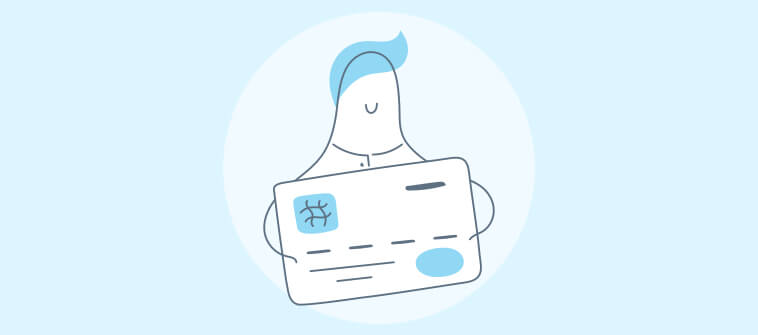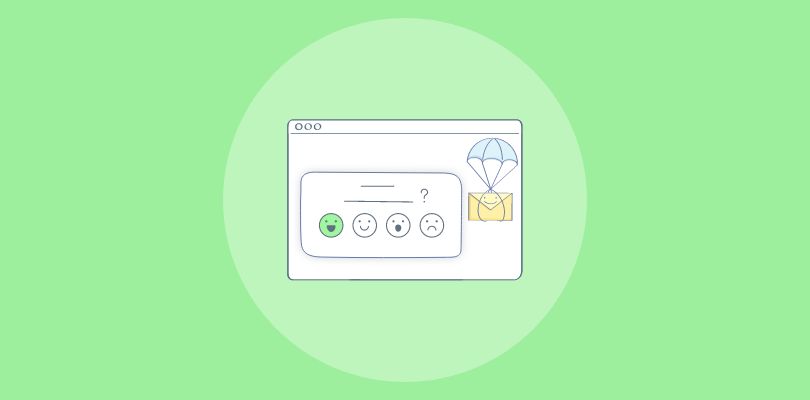
Every founder dreams of customers who rave about their products and bring friends along. That’s loyalty money can’t buy—or can it?
However, here’s the harsh truth: ignoring unhappy customers can be costly. Bain & Company worked with Dell and learned that a meager 15% of NPS detractors, or unhappy customers, resulted in a loss of $68 million in revenue for the company. Ouch!
This is exactly why savvy entrepreneurs swear by NPS emails (Net Promoter Score emails). They’re deceptively simple: They ask customers, “On a scale of 0–10, how likely are you to recommend us?”
But simple doesn’t mean easy. Many founders sabotage their NPS approach with repetitive surveys, weak follow-ups, or generic messages nobody opens.
In this guide, you’ll master how to:
- Craft irresistible NPS emails that customers actually open and answer.
- Segment follow-ups to convert detractors into promoters and promoters into advocates.
- Avoid pitfalls like survey fatigue and confusing incentives.
- Close the feedback loop effectively to boost loyalty and growth.
Ready to turn your NPS strategy around? Let’s begin with what is NPS and where to use it!
What Is NPS and When Should You Use It?
NPS—or Net Promoter Score—is your business’s loyalty scorecard. It boils down to asking customers just one powerful question:
“On a scale of 0–10, how likely are you to recommend us to a friend or colleague?”
Simple enough, right? Customers answering your NPS survey fall into three groups:
- Promoters (9–10): Your fans who actively recommend you.
- Passives (7–8): Neutral customers who aren’t actively recommending you yet.
- Detractors (0–6): Unhappy customers who might actively discourage others from buying.
Calculating your NPS is simple:
NPS = % Promoters – % Detractors
If 60% of customers are promoters and 10% detractors, your NPS = 60% – 10% = 50. A higher NPS equals happier customers and more growth opportunities.
Here’s a quick video to help you calculate your NPS score:
But here’s the catch: Not all NPS surveys serve the same purpose.
- Relationship NPS: Sent quarterly or bi-annually, these measure overall brand loyalty. It’s like a regular health checkup—vital but not overly frequent.
- Transactional NPS: Sent right after key interactions (like purchases or customer support calls) to measure immediate customer experiences.
Timing matters. For example, sending transactional surveys soon after a customer interaction gets you precise feedback, while quarterly relationship surveys help track loyalty over time. But avoid bombarding your customers too frequently—nothing ruins engagement faster than survey fatigue.
By strategically using both survey types, you’ll gain clear, actionable insights into customer satisfaction and loyalty, enabling you to grow faster and smarter.
If you’re new to NPS and its creation, here’s another quick video for you to create an NPS Email Survey:
Why Email Is Your Best Friend for NPS Surveys
You might wonder—why email when there’s SMS, app notifications, or website pop-ups? Great question. Here’s the quick answer: email simply delivers better results.
Here’s why savvy founders lean into email for their NPS surveys:
1. You Reach More Customers
Almost everyone checks their email daily. Unlike SMS or pop-ups, email connects with a broader customer base, increasing your chances of meaningful engagement.
2. You Get Higher Response Rates
Emails are less intrusive than pop-ups and easier to respond to than texts, resulting in higher-quality responses. Better responses mean better insights, and better insights drive growth.
3. You Control the Narrative
Emails let you clearly explain why you’re reaching out and how customer feedback helps. Context builds trust—customers are more likely to respond thoughtfully if they know their input matters.
4. Embed Surveys Right in the Email
Want dramatically higher response rates? Embed the NPS question directly within your email. Customers rate you with a single click—reducing friction, boosting response, and saving valuable time.
5. Easy Tracking and Analytics
Email makes measuring your success simple. You see exactly who opened, clicked, and responded. No guesswork, just clear data to improve future campaigns.
6. Branded, Mobile-Friendly Experience
You control email design, keeping surveys aligned with your brand. Optimizing emails for mobile ensures you capture valuable feedback—even on-the-go.
Bottom line? Emails offer unmatched flexibility, reach, and precision for collecting customer feedback. Use them smartly, and watch your customer loyalty soar.
20+ Proven Strategies for Creating High-Impact NPS Emails (Step-by-Step Strategy)
You’ve got one clear job here: get useful, actionable feedback from your customers without overwhelming or annoying them. Here’s your ultimate playbook—20 powerful, actionable steps designed to elevate your NPS survey emails from “meh” to magnetic:
1. Write a Subject Line Customers Can’t Ignore
Your Customer’s Job: Recognize this email as important and open it.
Do This Exactly:
- Open your email composer.
- Type a short, personalized subject line that creates curiosity or urgency, like:
“Quick question, [Name]—can you help?”
“[Name], your feedback matters (takes 10 seconds!)”
2. Personalize the Email Intro Clearly
Your Customer’s Job: Immediately understand this message is specifically for them.
Do This Exactly:
- Start your email with a greeting using their first name.
- Reference a specific recent event or interaction.
Example (copy-paste ready):
“Hi [Name], thanks again for your recent purchase! We’re always looking to improve, and your feedback matters greatly to us.”
3. Embed the NPS Question Directly Inside the Email
Your Customer’s Job: Effortlessly answer your survey with a single click.
Do This Exactly:
- Embed the NPS scale (0–10 rating buttons) right into your email body.
- Underneath, include clear, concise instructions.
Example (copy-paste ready):
On a scale from 0 (not likely) to 10 (extremely likely), how likely are you to recommend us to a friend?
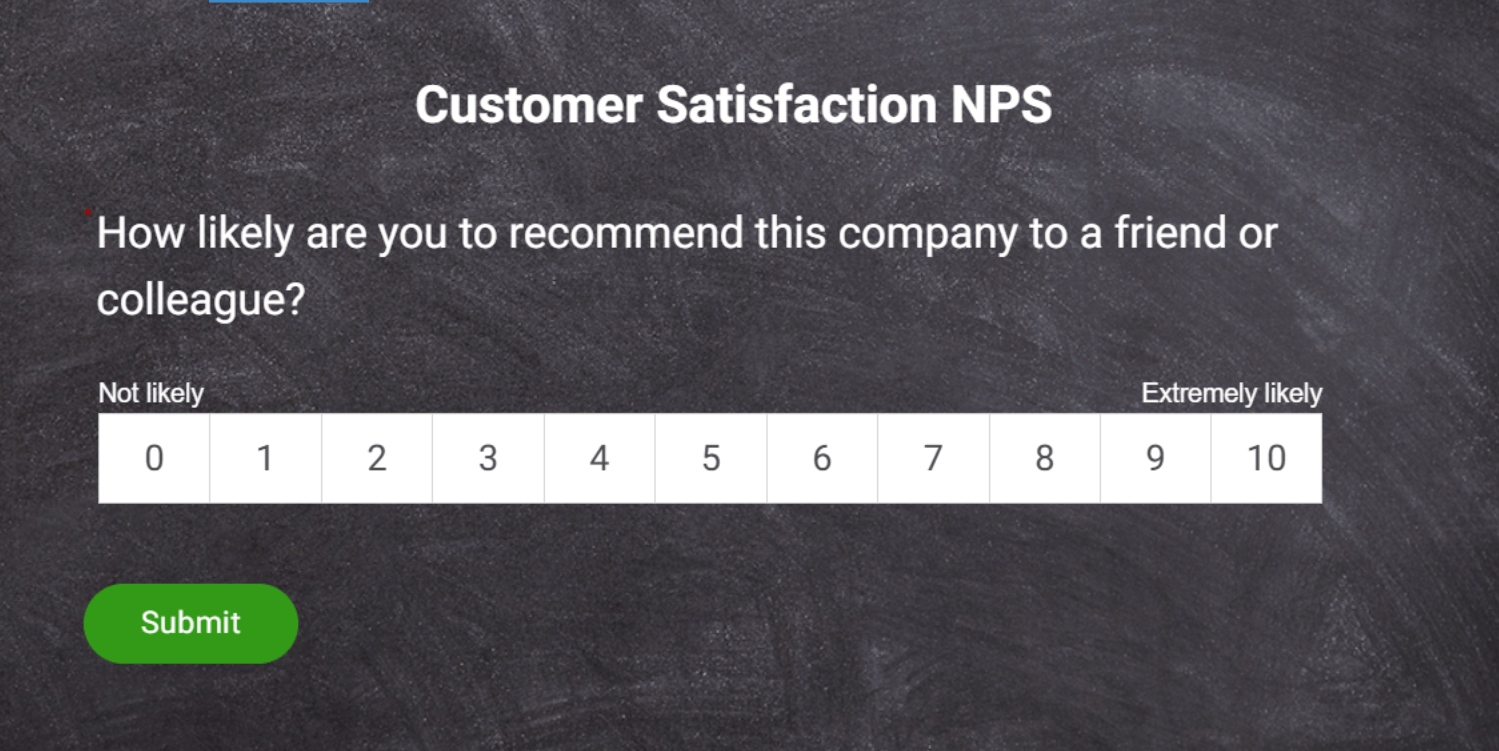
4. Add an Optional (but Valuable) Follow-Up Question
Your Customer’s Job: Share additional context or reasons behind their rating.
Do This Exactly:
- After they click their rating, automatically direct them to a simple follow-up survey page.
- Clearly instruct them what you’d like to hear.
Example (copy-paste ready):
“Thanks for your feedback! Mind sharing quickly what we could do better?”
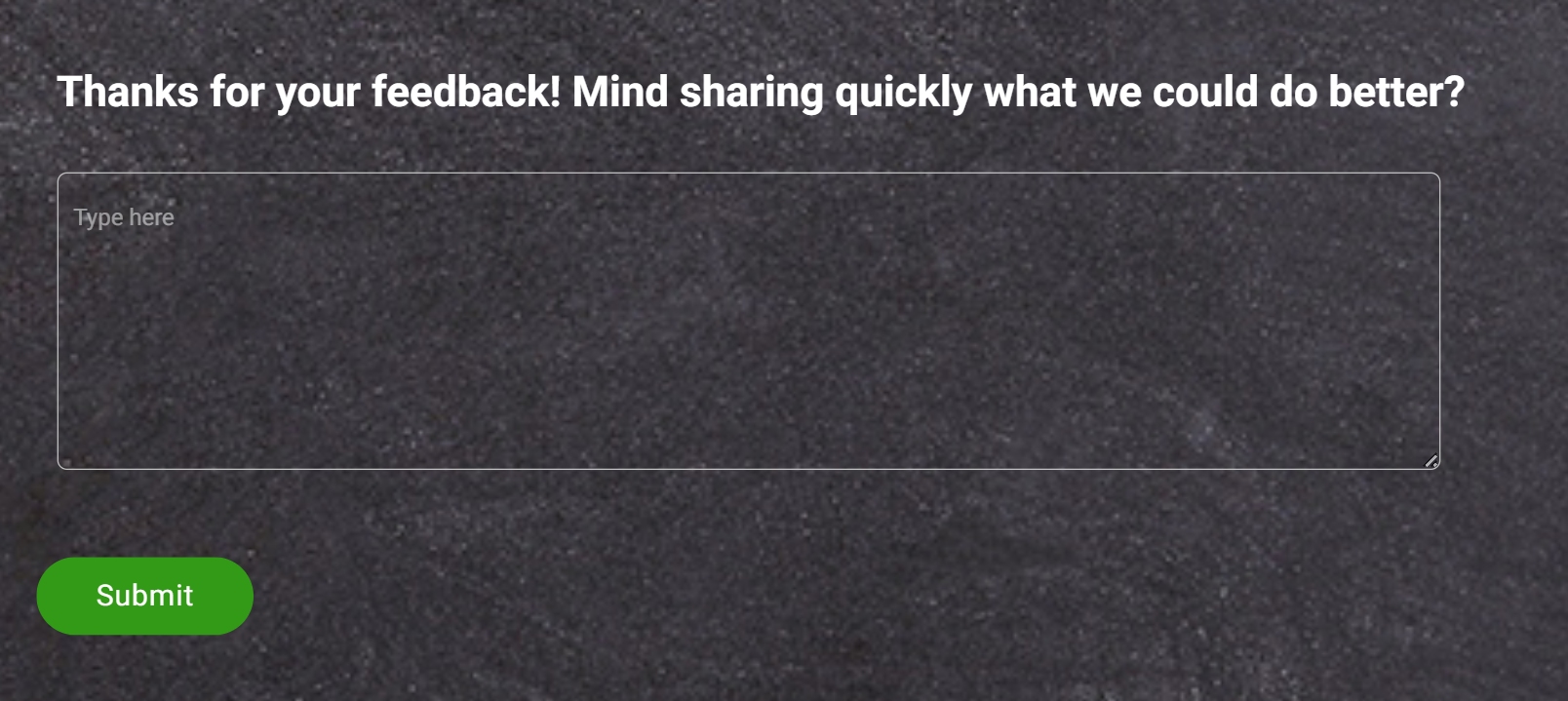
5. Make Sure Your Email Is Mobile-Friendly
Your Customer’s Job: Read and respond easily on their smartphone.
Do This Exactly:
- Before sending, send a test email to your own smartphone.
- Confirm the subject line and the embedded NPS scale look clear and clickable without zooming or scrolling.
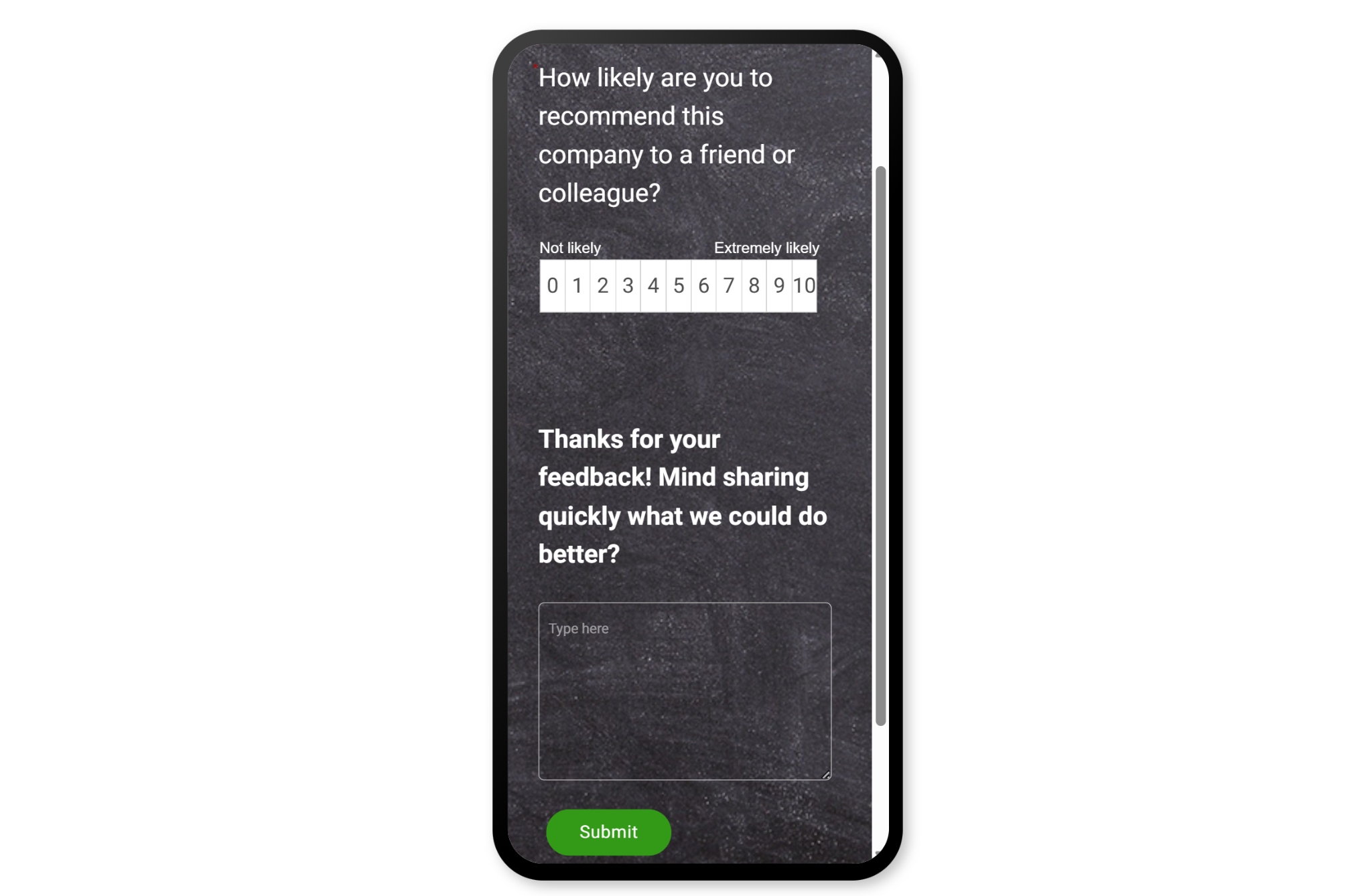
6. Choose the Right Sender
Your Customer’s Job: Trust and open the email without hesitation.
Do This Exactly:
- Set the email sender to be a real, recognizable name from your team—never use a “no-reply” address.
- Use a name like “Alex at [Company Name]” or “Jen from Customer Success.”
7. Send Emails at the Perfect Moment
Your Customer’s Job: Provide accurate feedback when their experience is still fresh.
Do This Exactly:
- For Transactional NPS, send within 24 hours after a customer interaction (purchase, support call).
- For Relationship NPS, schedule once per quarter to measure general brand sentiment.
8. Segment and Follow Up on Responses Immediately
Your Customer’s Job: Feel heard, valued, and reassured you’ll act on their input.
Do This Exactly:
- If Promoter (score 9–10):
Immediately send a warm thank-you email. Embed a Qualaroo nudge on the thank-you or post-click page to capture deeper feedback right away.
Politely ask for a referral or review.
- If Passive (score 7–8):
Ask them directly what it would take to move from “good” to “great.”
- If Detractor (score 0–6):
Personally reach out within 24–48 hours.
Apologize, clearly acknowledge their pain points, and offer specific solutions.
(Automate follow-ups using your email/survey software to streamline the process. You can use ProProfs Survey Maker to create and schedule your NPS surveys.)
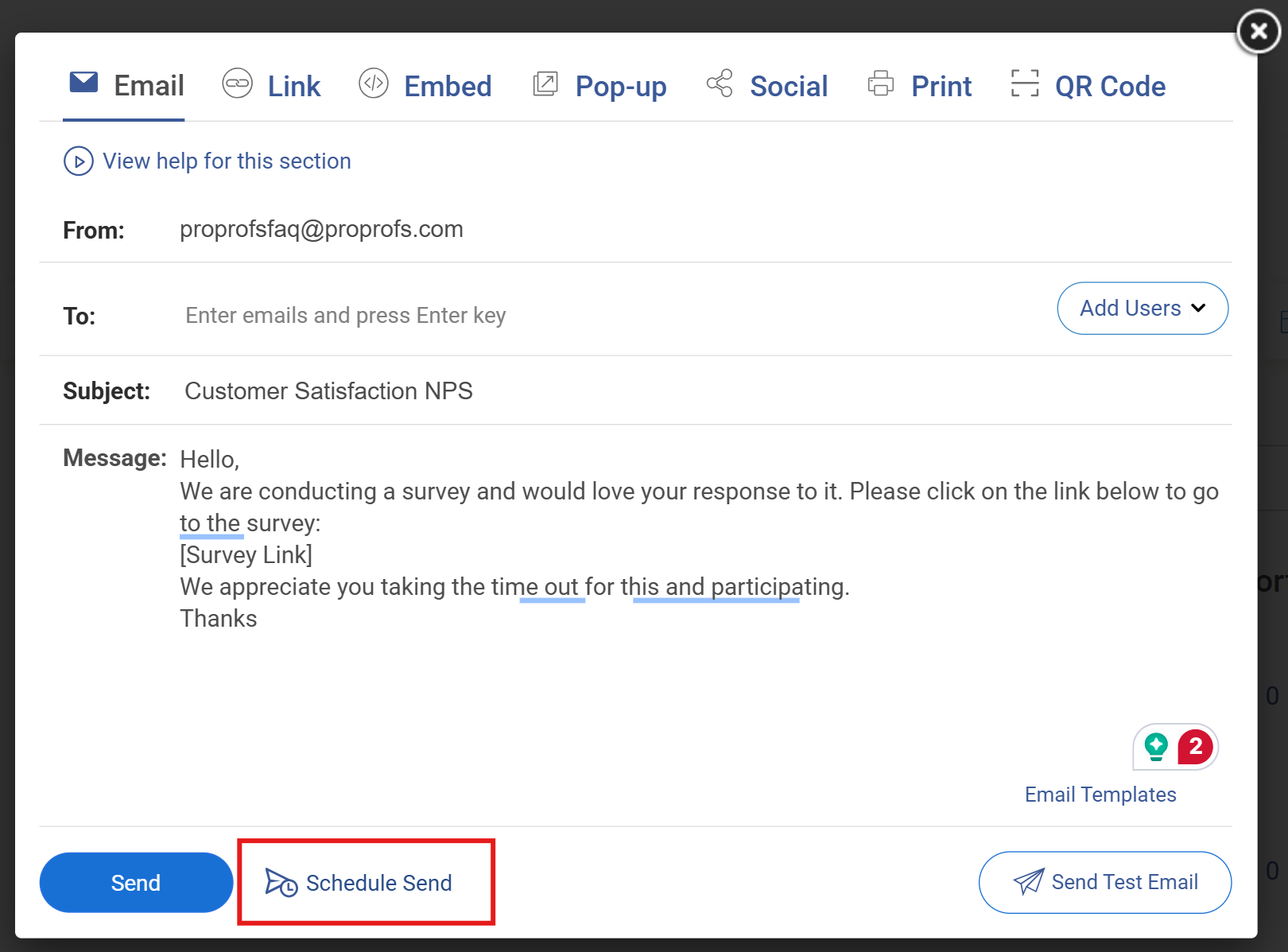
9. Close the Feedback Loop Clearly
Your Customer’s Job: Trust that their input leads to actual improvements.
Do This Exactly:
- After collecting and analyzing responses, send a short, concise follow-up email to respondents.
- Clearly communicate any changes made based on their feedback.
Example (copy-paste ready):
“Thanks again for your feedback! You spoke, we listened—here’s how we’re improving based on your suggestions…”
10. Test, Measure, Improve, Repeat
Your Customer’s Job: Consistently receive better, clearer, more relevant emails.
Do This Exactly:
- Run A/B tests on different subject lines, send times, and messaging.
- Track open rates, click rates, and response rates weekly.
- Keep what works, ditch what doesn’t, and continually refine your strategy.
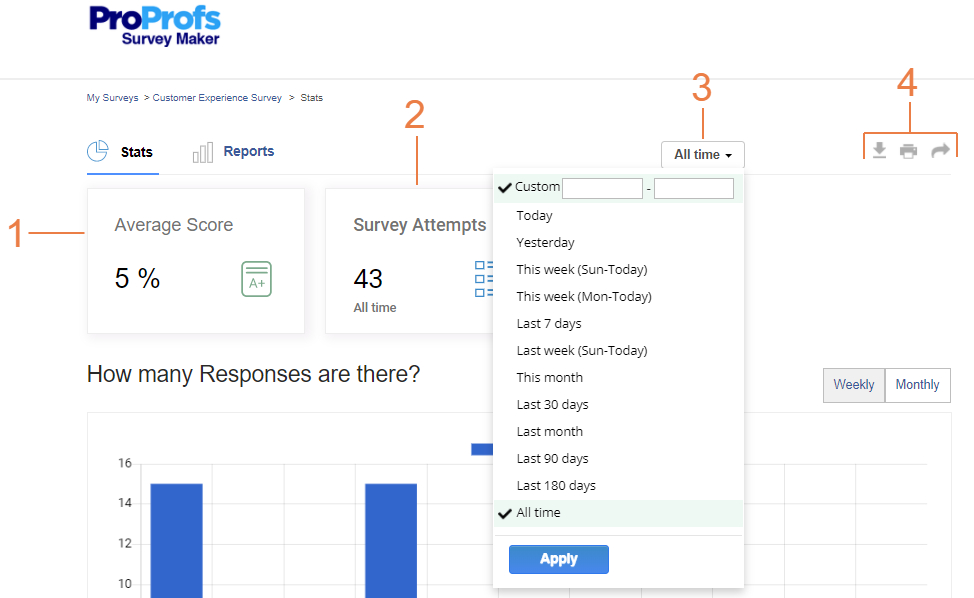
11. Warm Them Up with a Micro-Commitment
Your Customer’s Job: Easily begin engaging with your email without hesitation.
Do This Exactly:
- Embed a simple yes/no question directly in your email before the main NPS question.
- Immediately follow up their answer by presenting your primary NPS question, making them more likely to respond.
Example (copy-paste ready):
Did your recent order arrive safely?
[Yes] [No]
12. Clearly Show Real-Time Progress
Your Customer’s Job: Instantly know your survey will be quick and hassle-free.
Do This Exactly:
- At the very top of your email or embedded survey, clearly state the number of steps involved.
- Make sure customers see upfront that your survey won’t take much of their time.
Example (copy-paste ready):
Step 1 of 2: On a scale from 0 (not likely) to 10 (extremely likely), how likely are you to recommend us?
13. Create Urgency with a Gentle Deadline
Your Customer’s Job: Feel motivated to provide immediate feedback instead of delaying.
Do This Exactly:
- Clearly state when you’ll be reviewing responses, creating gentle urgency for them to act right away.
- Reassure customers that their timely response directly influences your decisions or improvements.
Example (copy-paste ready):
“We’re reviewing all feedback this Friday—your response will directly help us improve your experience.”
14. Humanize Your Email with a Personal Photo
Your Customer’s Job: Immediately trust and feel connected with your survey request.
Do This Exactly:
- Add a friendly, professional headshot of the email sender at the beginning or end of your email.
- Clearly introduce the sender by name and role, making your request feel genuine and personal.
Example (copy-paste ready):
“Hi, I’m Jessica from Customer Success—your feedback helps our entire team!” (Include sender’s photo here.)
15. Immediately Offer Support for Low Ratings
Your Customer’s Job: Receive instant reassurance and an easy path to resolve their dissatisfaction.
Do This Exactly:
- Automatically direct customers who select a low NPS rating (0–6) to book a quick support call or chat.
- Clearly show customers you’re committed to fixing their issue immediately.
Example (copy-paste ready):
“We’re sorry your experience wasn’t great—let’s fix this right away. Click here to schedule a quick support call.”
16. Highlight Specific Improvements Driven by Feedback
Your Customer’s Job: Clearly see that their past feedback has made a tangible difference.
Do This Exactly:
- Briefly share recent changes or improvements you’ve made based directly on customer feedback.
- Clearly ask for their input again, reinforcing that their voice truly matters.
Example (copy-paste ready):
“Your feedback helped us launch faster shipping—tell us how else we can improve.”
17. Leverage Emotional Triggers (Authentically)
Your Customer’s Job: Feel like their response truly matters and is appreciated.
Do This Exactly:
- Express gratitude or invite feedback in a way that feels personal and sincere.
- Use friendly, emotionally resonant language without being manipulative or overdone.
Example (copy-paste ready):
“You’ve been a huge part of our journey—can you take 30 seconds to help us get even better?”
18. Embed a Short, Friendly Video
Your Customer’s Job: Instantly connect with the person behind the survey request.
Do This Exactly:
- Record a short (15–30 second) video from the founder or team member explaining why their feedback matters.
- Embed the video thumbnail in the email with a clear play button and short caption.
Example (copy-paste ready):
Hi! I’m Alex, one of the founders. We obsess over customer feedback—and this quick survey helps us improve. Click to play → [Video Thumbnail]
19. Use an Animated GIF to Gently Draw Attention
Your Customer’s Job: Notice the survey element without feeling overwhelmed or distracted.
Do This Exactly:
- Add a subtle GIF that animates your NPS scale or highlights the CTA button.
- Keep it slow and low-key—avoid flashy or looping graphics that feel spammy.
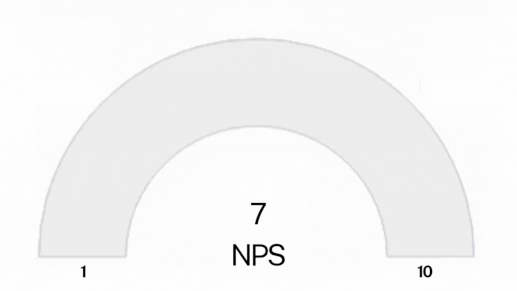
Example (copy-paste ready):
Include a GIF where the NPS scale pulses once, drawing attention to: “On a scale of 0 to 10, how likely are you to recommend us?”
20. Ask for Permission During Onboarding
Your Customer’s Job: Feel respected and informed about future survey communication.
Do This Exactly:
- Include a checkbox or clear line during onboarding or signup that asks if they’re open to receiving occasional feedback requests.
- Honor that setting and only survey customers who’ve opted in.
Example (copy-paste ready):
“We’d love to send you a quick survey now and then to help improve your experience. Is that okay?”
[✔] Yes, I’m happy to help improve [Brand Name].
21. Reinforce NPS Email Feedback with Follow-Up Nudges
Your Customer’s Job: Easily elaborate on their email survey response without switching channels or getting overwhelmed.
Do This Exactly:
- After a customer clicks a rating in your NPS email, route them to a short thank-you landing page or confirmation screen.
- On that page, trigger a Qualaroo nudge to collect deeper, open-ended feedback based on their score:
If detractor: “What frustrated you most about your recent experience?”
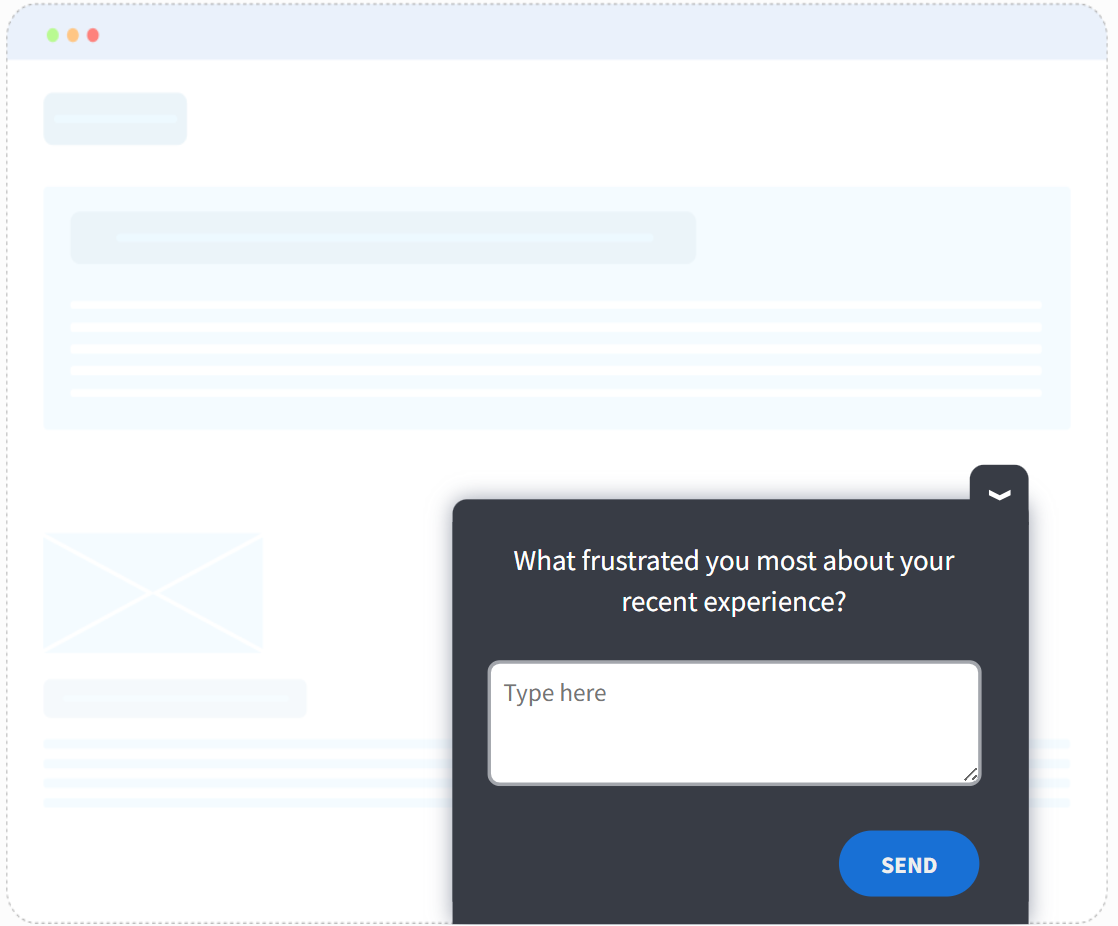
If promoter: “What did you love most? Would you be open to sharing a review?”
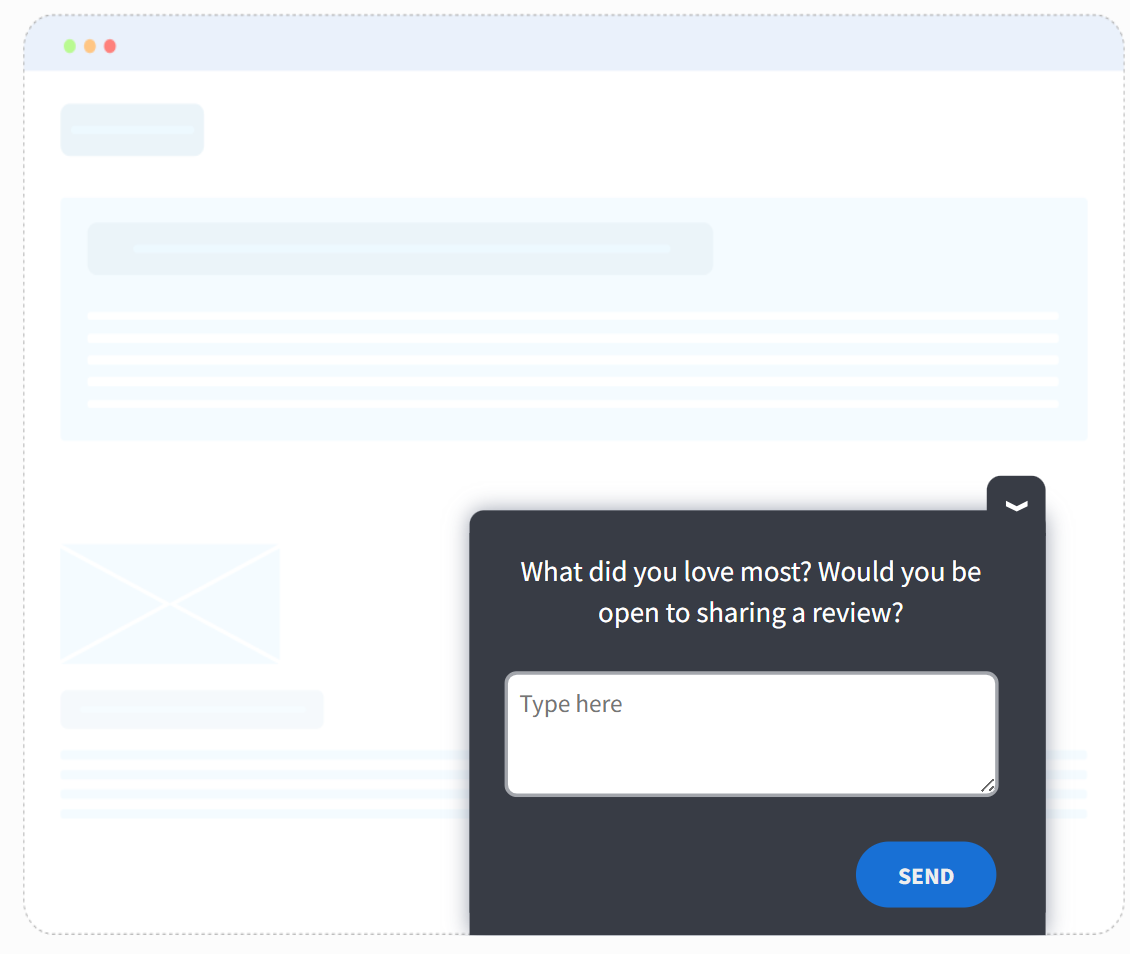
This lets you collect qualitative insights without forcing users to fill out lengthy forms.
Example (copy-paste ready):
When a customer selects a score in the email and lands on your confirmation page, trigger a nudge:
“Thanks for your response! Can you tell us why you gave us a [score]?”
NPS Email Examples (Ready-to-Use Templates for Different Scenarios)
You’ve built the strategy. Now it’s time to execute without overthinking every word.
These plug-and-play NPS email templates are designed to do one job: get honest, useful feedback with minimal friction.
Just copy, tweak the names and links, and send.
1. Customer Satisfaction NPS Email Template
When to Use: After a purchase, onboarding, or any key milestone in the customer journey.
Subject Line (choose one):
- Quick question about your recent experience
- How did we do? (It only takes 10 seconds)
Email Body:
Hi [Customer Name],
Thanks for choosing [Product/Company]! We’re always working to deliver a better experience, and your quick feedback would mean the world to us.
It’s just one click. After that, we may ask a quick follow-up so we can improve.
[Survey Link]
Thanks again,
[Your Name]
Founder, [Company Name]
2. Detractor Follow-Up Email (0–6 Score)
When to Use: After someone gives you a low score via your NPS email.
Subject Line: We hear you—and we want to make it right
Email Body:
Hi [Customer Name],
Thank you for your honest feedback. I’m sorry we fell short this time. I’d love to hear what went wrong so we can fix it—not just for you, but for others too.
If you’re open to it, just hit reply or schedule a quick 5-minute chat [Insert link].
You can also drop your thoughts here: [Qualaroo nudge or form link]
We’re listening—and we’ll act.
Sincerely,
[Your Name]
Founder, [Company Name]
Note: For Qualaroo, you can use a Link Nudge to email these short, in-the-moment surveys.
3. Promoter Follow-Up Email (Score 9–10)
When to Use: After a customer gives you a high NPS score. It’s the perfect time to ask for a referral, review, or testimonial.
Subject Line: Glad you loved it—can you help us grow?
Email Body:
Hi [Customer Name],
Thank you so much for your feedback—we’re thrilled to hear you had a great experience!
If you know someone who’d benefit from [Product/Company], feel free to share us with them. You can also leave us a quick review here: [Insert link]
It helps us grow and helps others find the right solution too.
Thanks again for being part of our journey.
Cheers,
[Your Name]
Founder, [Company Name]
4. Passive Follow-Up Email (Score 7–8)
When to Use: When a customer gives you a neutral score—not unhappy, but not quite excited either. Your goal is to learn what would push them to a 9 or 10.
Subject Line: How can we make this a 10?
Bonus: Here, you can also add a short microsurvey using Qualaroo as customers might not have the time to reply to your mail.
Email Body:
Hi [Customer Name],
Thanks for your feedback! We’re glad things went well—but we’d love to do even better.
If there’s anything we could improve to turn your experience into a 10, we’d really like to know. Just hit reply and share your thoughts—big or small.
Appreciate your time and honesty.
Best,
[Your Name]
Founder, [Company Name]
5. Post-Onboarding NPS Email
When to Use: 1–2 weeks after a customer completes onboarding. Great time to catch early impressions.
Subject Line: Now that you’ve settled in—how’s it going?
Email Body:
Hi [Customer Name],
You’ve been using [Product/Platform] for a little while now, and we’d love to know how things are going so far.
On a scale from 0 (not likely) to 10 (extremely likely), how likely are you to recommend us to a friend or colleague?
[0] [1] [2] [3] [4] [5] [6] [7] [8] [9] [10]
OR
[Survey Link]
Your feedback helps us spot what’s working—and fix what’s not. It only takes a click.
Thanks for helping us improve,
[Your Name]
Founder, [Company Name]
6. Churn Feedback NPS Email
When to Use: Right after a customer cancels their subscription or account. Use it to understand why they left—and how you can win them back.
Subject Line: We’re sorry to see you go—can you tell us why?
Email Body:
Hi [Customer Name],
We’re sorry to see you go, but we truly appreciate the time you spent with us. If you have a quick moment, we’d love to understand your decision a little better.
On a scale from 0 (not likely) to 10 (extremely likely), how likely are you to recommend us to others—despite canceling?
[0] [1] [2] [3] [4] [5] [6] [7] [8] [9] [10]
OR
[Survey Link]
Every response helps us learn and improve—no hard feelings, just honest feedback.
Thanks again,
[Your Name]
Founder, [Company Name]
FREE. All Features. FOREVER!
Try our Forever FREE account with all premium features!
Common NPS Email Pitfalls & Exactly How to Avoid Them
Your next critical job is to prevent costly mistakes founders often unknowingly make with NPS surveys.
Here’s a quick skimmable table for you to quickly learn what not to do:
| Pitfall | What Happens | How to Avoid It |
|---|---|---|
| Sending too many surveys | Customers ignore or unsubscribe | Limit to key touchpoints; set 30-day blackout per user |
| Ignoring customer responses | Customers feel unheard and disengage | Respond within 24–48 hrs, especially to low scores |
| Using generic, non-personalized emails | Low open and response rates | Personalize subject line, sender name, and intro |
| Offering incentives for NPS scores | Responses become biased and less useful | Avoid score-based rewards; show improvements instead |
| Managing inaccurate or duplicate data | Skewed NPS scores and bad decisions | Tie responses to customer ID; avoid overlapping surveys |
| Sending from a no-reply address | Emails feel robotic and untrustworthy | Use a real name and a monitored reply-to address |
| Not capturing open-ended feedback | You only get a number, not context | Use follow-up questions or a Qualaroo nudge post-click |
Here’s exactly how to avoid each one, step by step:
Pitfall #1: Sending Too Many Surveys (Survey Fatigue)
Customer’s job: Not feel annoyed or overwhelmed by your requests.
Do this exactly:
- Limit Relationship NPS surveys to quarterly at most.
- Send Transactional NPS surveys only after significant interactions (purchases, support interactions).
- Add a minimum 30-day blackout period for each customer between surveys.
Quick Check: Before hitting send, check if this customer received an NPS survey within the past 30 days. If yes, skip for now.
Pitfall #2: Ignoring Customer Responses
Customer’s job: Know their input matters and see action taken.
Do this exactly:
- Send an automatic acknowledgment immediately after they respond.
- Within 24–48 hours, personally respond to all detractors (scores 0–6) to resolve concerns.
- Within one week, inform all respondents briefly about actions you’ve taken based on their feedback.
Copy-Paste Example: “Thanks for your feedback, [Name]! We’ve already implemented [specific improvement] based on your input.”
Pitfall #3: Using Generic, Non-Personalized Emails
Customer’s job: Recognize immediately that the email is relevant and personal.
Do this exactly:
- Personalize every email subject line and intro with their name and recent activity.
- Avoid generic wording—make it feel specific to their recent experience.
Good Example: “Hi [Name], thanks for upgrading! Can we get your quick feedback?”
Pitfall #4: Unclear or Confusing Incentives
Customer’s job: Provide genuine, unbiased feedback.
Do this exactly:
- Avoid offering rewards or discounts specifically for NPS responses—these can lead to biased answers.
- If incentives are necessary, offer them after customers complete follow-up questions, clearly stating the reward isn’t linked to their specific rating.
Correct Wording Example:
“Complete this quick feedback and unlock a thank-you bonus—regardless of how you rate us.”
Pitfall #5: Inaccurate Data Management
Customer’s job: Trust that their feedback contributes accurately to company decisions.
Do this exactly:
- Ensure your survey tool counts each customer only once per survey cycle.
- Use unique identifiers (email or user ID) to avoid multiple entries from one respondent.
- Clearly distinguish between Relationship NPS and Transactional NPS in your data analytics.
Quick Data Check: Before analyzing NPS scores, quickly filter data for duplicates by email or customer ID.
Pitfall #6: Sending Emails from “No-Reply” Addresses
Customer’s job: Feel they can easily communicate back if needed.
Do this exactly:
- Always set your sender name to a recognizable person within your company.
- Provide a reply-to address monitored by your team.
Example Sender:
“Jessica from Customer Success”
Reply-to: jessica@[yourcompany].com
How to Close the Feedback Loop (Without Letting Responses Die in a Spreadsheet)
Collecting NPS responses is just the beginning. The real ROI happens when you act on the feedback—quickly, personally, and visibly.
Here’s exactly how to close the loop, step by step:
1. Respond Fast—Especially to Detractors
Your Customer’s Job: Feel heard, respected, and taken seriously.
Do This Exactly:
- Set up real-time alerts for NPS scores 0–6.
- Respond personally within 24–48 hours, even if you don’t have a solution yet.
- Show empathy first, then move to resolution.
Example (copy-paste ready): “Thanks for your honest feedback, [Name]. We’re really sorry this didn’t go as expected. I’d love to learn more and fix this for you.”
2. Follow Up with Passives to Understand the Gap
Your Customer’s Job: Feel like their opinion is valued—not ignored just because it wasn’t extreme.
Do This Exactly:
- Email passives (7–8) and ask: “What would have made this a 9 or 10?”
- Log recurring suggestions to your CX backlog.
Example (copy-paste ready): “Thanks for the feedback, [Name]—we’d love to know what could’ve made your experience a perfect 10.”
3. Mobilize Promoters—They’re Your Secret Growth Engine
Your Customer’s Job: Feel appreciated and excited to help you grow.
Do This Exactly:
- Send a warm thank-you.
- Invite them to leave a review, refer a friend, or be featured in a testimonial.
- Bonus: Offer early access or beta invites as a thank-you.
Example (copy-paste ready): “We’re thrilled you had a great experience! Would you consider leaving a quick review or sharing us with a friend? It helps us a lot.”
4. Keep a Feedback Log & Close the Loop Publicly
Your Customer’s Job: See proof that their feedback turns into action.
Do This Exactly:
- Track all feedback by score segment (Promoter/Passive/Detractor).
- Every 30–60 days, send a “You said, we did” update to all recent NPS respondents.
- Optionally use a Qualaroo nudge inside your app to show what’s changed.
Example (copy-paste ready): “You asked for faster load times—we shipped it. Thanks for helping us improve!”
From Scores to Strategy: Turning NPS Emails Into Growth
If you’ve made it this far, you already know—NPS emails aren’t about scores. They’re about momentum.
When you combine the right message, timing, and follow-up, that one question can unlock customer insight, retention, and referrals—without the overhead of long surveys or guesswork.
Here’s the playbook in short:
- Embed the NPS scale directly in the email
- Personalize the sender, subject, and content
- Segment follow-ups by score
- Use Qualaroo to capture quick, post-click feedback
- Keep it short, mobile-first, and timely
- Respond fast—especially to low scores
- Turn promoters into referrers
- Close the loop publicly
- Test everything: NPS email subject lines, timing, sender
Tools like ProProfs Survey Maker make this easier—letting you create surveys with AI and extend email surveys with smart, targeted NPS emails that collect deeper insights right when customers are most engaged.
Done right, NPS emails don’t just measure loyalty—they build it.
FREE. All Features. FOREVER!
Try our Forever FREE account with all premium features!

 We'd love your feedback!
We'd love your feedback!
 Thanks for your feedback!
Thanks for your feedback!






